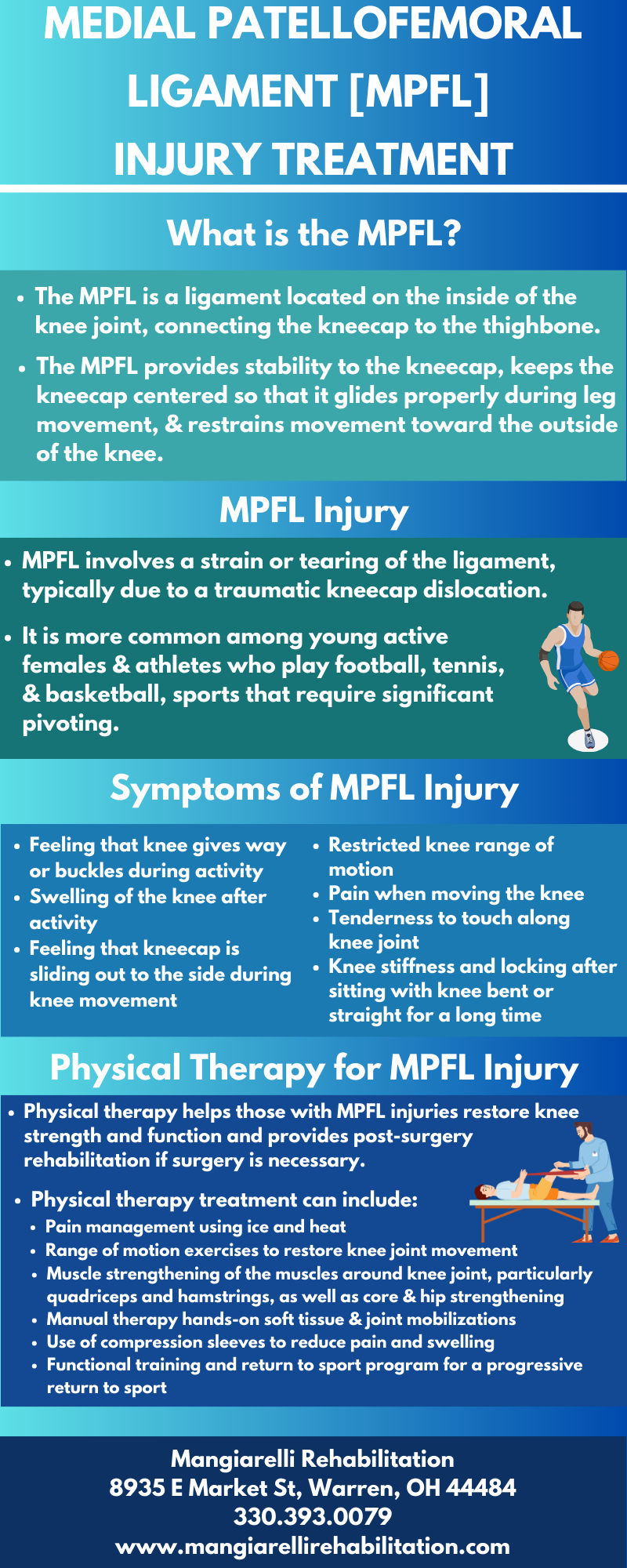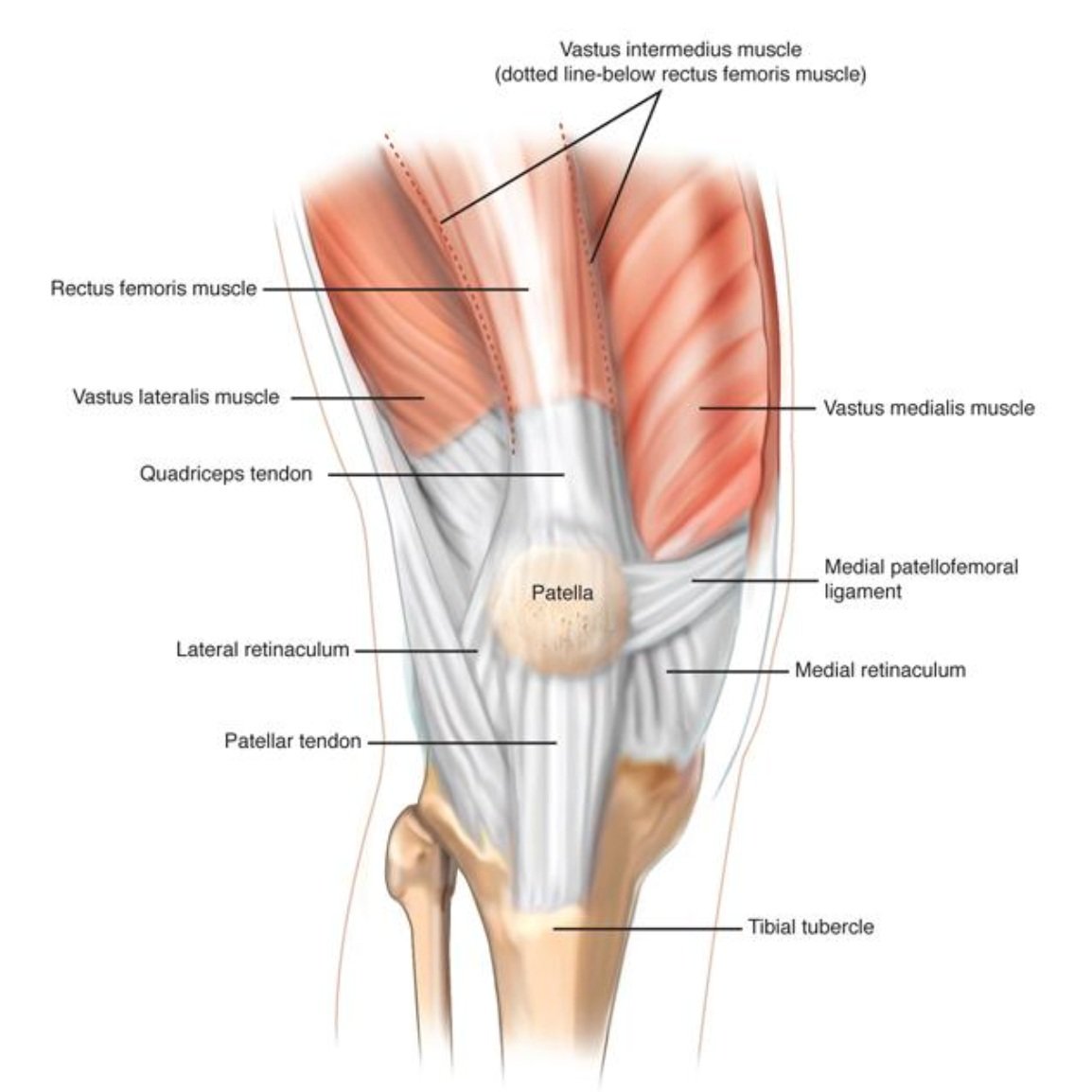Medial Patellofemoral Ligament Injury Treatment [Infographic]
A MPFL injury involves a strain or tearing of the medial patellofemoral ligament, typically due to a traumatic kneecap dislocation during sports competition. The MPFL is a part of a complex of soft tissues that stabilize the knee and is a ligament that attaches the inside part of the kneecap to the femur. MPFL injury and kneecap dislocations are more common among young active females and athletes who play football, tennis, and basketball, sports that require significant pivoting. Physical therapy plays an important role in helping athletes recover from MPFL injury and surgery, helping to restore knee strength, mobility, and function and minimize the risk of recurrent patellar dislocation and instability.
What is the Medial Patellofemoral Ligament [MPFL]?
The medial patellofemoral ligament (MPFL) is part of a complex of soft tissues that stabilize the knee. The MPFL is a ligament that attaches the inside part of the kneecap, or patella to the femur (long bone of the thigh). The MPFL keeps the kneecap moving smoothly inside the trochlear groove of the femur, providing stability to the knee and preventing lateral movement of the patella.
How MPFL Injury Occurs
A MPFL injury involves a strain or tearing of the medial patellofemoral ligament, typically due to a traumatic kneecap dislocation during sports competition. When a kneecap dislocation occurs, the soft tissues around the knee are damaged as the kneecap “jumps” the track [trochlear groove of the femur] and then comes forcibly back into place. The kneecap dislocates toward the outside of the leg, causing the MPFL to be stretched or torn. Research has shown that 94% of patients suffer a tear to the MPFL following a patellar dislocation on the lateral side.
MPFL injury and kneecap dislocations are more common among young active females and athletes who play football, tennis, and basketball, sports that require significant pivoting. In fact, research shows that 61% of primary kneecap dislocations occur during sports activities and are most often seen in teens and young adults.
Causes of MPFL injury include:
Direct blow to the kneecap from sports injury, fall, or another accident
Uneven or shallow trochlear groove in the knee
Extremely flexible joints or loose ligaments
Loose connective tissue due to conditions like Ehlers-Danlos syndrome, cerebral palsy, or Down Syndrome
Playing sports that involves quick pivot like soccer, basketball, or cheerleading
Individuals who have weak leg muscles or chronic weak knee muscles may be at greater risk of an MPFL injury and patellar dislocation. Those who have had a previous knee dislocation or patellofemoral instability are also at a higher risk of suffering another knee dislocation. According to research, after an initial patellar dislocation and MPFL injury, up to 60% of individuals can develop recurrent patellar instability. Within 10 years of a first-time dislocation, 22.4% of people redislocate their patella with the highest rate of dislocation among 10-to-17-year-old girls at 36.8%.
Symptoms of MPFL injury can include:
Feeling that knee gives way or buckles during activity
Swelling of the knee after activity
Feeling that kneecap is sliding out to the side during knee movement
Restricted knee range of motion
Pain when moving the knee
Tenderness to touch along knee joint
Knee stiffness and locking after sitting with knee bent or straight for a long time
Cracking or creaking sounds with knee movement
Treating MPFL Injury with Physical Therapy
Physical therapy plays an important role in helping athletes recover from MPFL injury and surgery, helping to restore knee strength, mobility, and function and minimize the risk of recurrent patellar dislocation and instability. The therapist conducts an initial evaluation to assess the injured knee’s range of motion, strength, mobility, and flexibility compared to the uninjured knee.
If surgery is required due to severe injury or if the individual has had previous kneecap dislocations, post-surgical physical therapy is essential to restore full function in the knee. The most common type of surgery for MPFL injury is MPFL reconstruction, which involves reconstructing the MPFL using a hamstring tendon to stabilize the knee and protect the knee joint from additional damage. Research has noted that MPFL reconstruction has excellent functional results and a very low rate of re-dislocation of the kneecap.
Physical therapy treatment for MPFL injury and post-MPFL reconstruction can include:
Initially, the knee may be immobilized, while ice and heat are used to manage pain and swelling around the knee. A compression sleeve may be used to help reduce swelling and support the injured joint.
The therapist then implements gentle range of motion exercises to help restore knee joint movements. Manual therapy hands-on soft tissue and knee joint mobilizations are used to help regain joint flexibility and manage pain.
The therapist then moves on to targeted strengthening of the muscles around the knee joint to help manage the force applied to the knee. The therapist specifically targets the quadriceps and hamstrings for strengthening and for balanced muscular support for proper knee alignment.
Core, gluteal, and hip strengthening are added to help balance the amount of force on the leg and knee and help maintain proper knee alignment to minimize the risk of a future patellar dislocation.
Functional training including walking, jogging, and running is introduced several months after surgery once the athlete has achieved an acceptable range of motion, muscle strength, and stability in the knee. The athlete is then progressed to sport-specific movements and proprioceptive and balance training drills to prepare for a safe return to sport, usually around 4 to 6 months post-surgery.
Use of a brace upon return to sport for additional support of the knee and proper knee alignment, particularly if the athlete has suffered a previous knee injury or patellar dislocation.
A patellar dislocation and subsequent injury to the MPFL can limit your mobility and function and prevent you from engaging in sports competition at the highest level. Work with a physical therapist to restore optimal knee strength, function, and range of motion for a safe return to sport after a MPFL injury!

